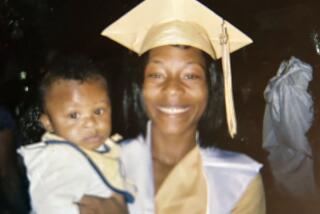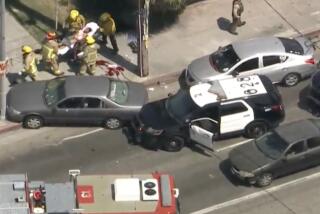Trial begins in 2005 chase
- Share via
Winston Hayes knows it was probably the “biggest mistake” of his life when he led Los Angeles County sheriff’s deputies on a low-speed chase through a Compton neighborhood three years ago: He was driving under the influence, evading arrest and was shot at 120 times by deputies during a wild incident captured by a freelance cameraman and televised on newscasts nationwide.
“Mr. Hayes is accepting full responsibility for the mistakes he made that evening,” Hayes’ attorney, Brian Dunn, told a jury Tuesday at the opening of a civil trial on the incident.
What Hayes, 46, now wants is for the 10 deputies who opened fire to pay him for their own actions May 9, 2005.
Jurors are being asked to consider whether the deputies’ misconduct and lack of fire control was so egregious that it overshadowed the crimes Hayes committed.
County officials have conceded that mistakes were made. After the shooting, Sheriff Lee Baca said the use of deadly force was excessive and handed out suspensions ranging from two to 15 days. The department also tightened its shooting policy, and nine of the deputies involved publicly apologized for putting residents in harm’s way.
According to sources, county lawyers sought to settle with Hayes for $500,000, but he wanted more.
On Tuesday, Deputy County Counsel Dennis M. Gonzales said deputies were justified in shooting at Hayes because they legitimately feared for their lives when it appeared he was going to run them down with his sport utility vehicle.
The trial is about “a tragic monster incident that was created by one man -- Winston Hayes,” Gonzales said.
Jurors were shown a clip of a video made by a freelance photographer, who captured the shooting. It showed deputies maneuvering on foot and in squad cars around Hayes’ SUV, followed by a heavy burst of fire. A deputy is shown slipping to one knee, then quickly getting back up. The SUV moves very slowly and taps a police car, coming to a halt. Then there is another burst of gunfire.
Dunn argued that the deputies weren’t properly trained and ignored the training they were given. Deputies were taught to avoid shooting at vehicles, and if they fired, to fire in two- and three-round bursts, “then stop and reassess,” Dunn said.
“Many of the deputies fired until they could not fire again, reloaded, and kept firing,” Dunn said. “The force used was excessive, unnecessary, and most important, it was deadly force.”
On the night of the incident, deputies were investigating a report of shots fired in Compton. Hayes’ vehicle, authorities said, was similar to the one described in the shots-fired report. As deputies approached Hayes’ SUV, he fled, leading them on a slow-speed chase around the neighborhood.
An audiotape was presented of a deputy monitoring the situation from a helicopter. She told pursuing deputies that Hayes’ white Suburban was moving “very erratically” and was involved in a series of near misses with police vehicles. Later, she warned deputies on the street below:
“It looks as though he’s actually aiming to hit deputies. You guys watch yourselves. He’s aiming to hit you.”
Hayes was shot several times during the barrage of gunfire but survived his injuries. A deputy was also hit in the crossfire, but the round struck his bulletproof vest.
Hayes has admitted using “primo” -- cocaine laced with marijuana -- before the incident, authorities said.
On Tuesday, jurors saw a video taken in a hospital emergency room 90 minutes after the shooting in which Hayes tries to refuse medical treatment and calls the doctors “devils” dozens of times.
Hayes is expected to testify that he was in his vehicle near his home when he heard shots fired. According to his attorney, Hayes fled because he didn’t know the men were deputies. Dunn said Hayes admits he should have stopped when squad cars with sirens and flashing lights and pursued. Instead, he drove for 10 minutes, until he was “cornered” on a residential street, Dunn said.
“He made probably the biggest mistake of his life -- not stopping immediately,” Dunn told jurors. Hayes, an ex-convict, recovered from his injuries, pleaded no contest to evading arrest and was sentenced to three years in prison. He was released in September 2006 after serving 452 days. Hayes’ criminal record shows five convictions in Los Angeles for misdemeanor resisting arrest, and prosecutors said they were prepared to present evidence of more arrests in Ventura and Orange counties.
L.A. County Superior Court Judge Rose Hom ruled that only one of the resisting arrest convictions may be introduced as evidence, finding the other incidents were too dissimilar to the 2005 chase to be useful to jurors.
The backgrounds of the deputies also have been at issue: Dunn said that at least four of the deputies involved had personal service histories that included the use of deadly force. But that information was also unlikely to be presented to the jury.
--
More to Read
Sign up for Essential California
The most important California stories and recommendations in your inbox every morning.
You may occasionally receive promotional content from the Los Angeles Times.













